As we lift our heads from the haze of the holidays and resolve to form better habits in the new year, it’s a good time to talk about one of the worst habits we saw in 2019: brands with lackluster Amazon content.
Online shoppers rely on detailed content to understand a product and its features, and there are many ways that brands can provide a curated and branded experience through Amazon content. Seasonal refreshes help brands avoid looking stale and out-of-date, which can turn customers off and ultimately lose conversions.
Imagine walking through a department store in mid-December and it’s still decked out for Thanksgiving, with no Christmas decorations or candy on display. A customer may feel like they’ve entered the Twilight Zone... and if they are looking to buy seasonal goods, they would go somewhere else.
It’s important for brands to think about their Amazon store and online presence just as they think of brick & mortar, with a content calendar planned well in advance to align with holidays, tentpole events, and sales. In this post, we will showcase a few brands who successfully implemented seasonal content during the 2019 holidays, and we’ll also take a look at a few retailers who have room to improve.
Examples of Seasonal Content on Amazon
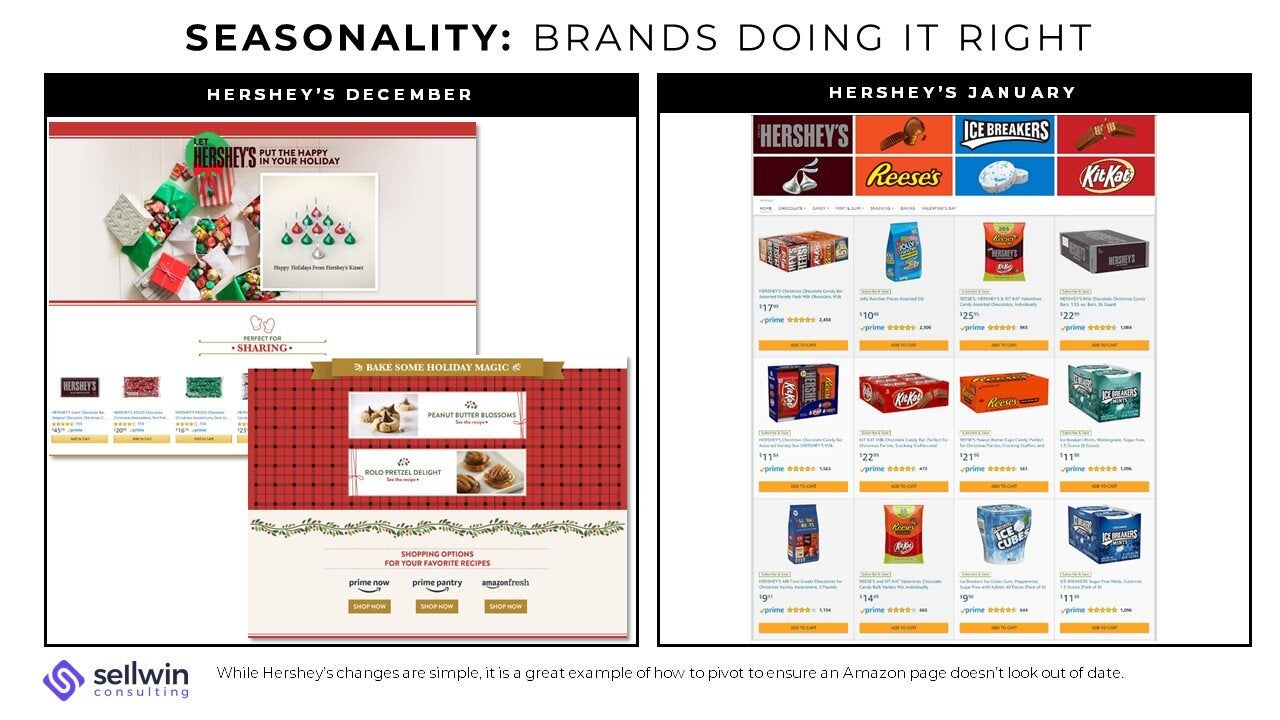
Brands Doing it Right: Hershey’s
During the holiday season, we snapped a screenshot of the Hershey’s store. The Hershey’s page was decked out with ‘deck the halls,’ and it was highly relevant and easy to navigate when buying both seasonal candy and staples. At the bottom of the page, they featured favorite holiday recipes.
Fast forward to January 2nd, and their page has already been updated to remove the Christmas cheer. While the changes are simple, it is a great example of how to pivot to ensure an Amazon page doesn’t look out of date. We are sure they are putting the final touches on a Valentine’s Day themed page to launch soon.
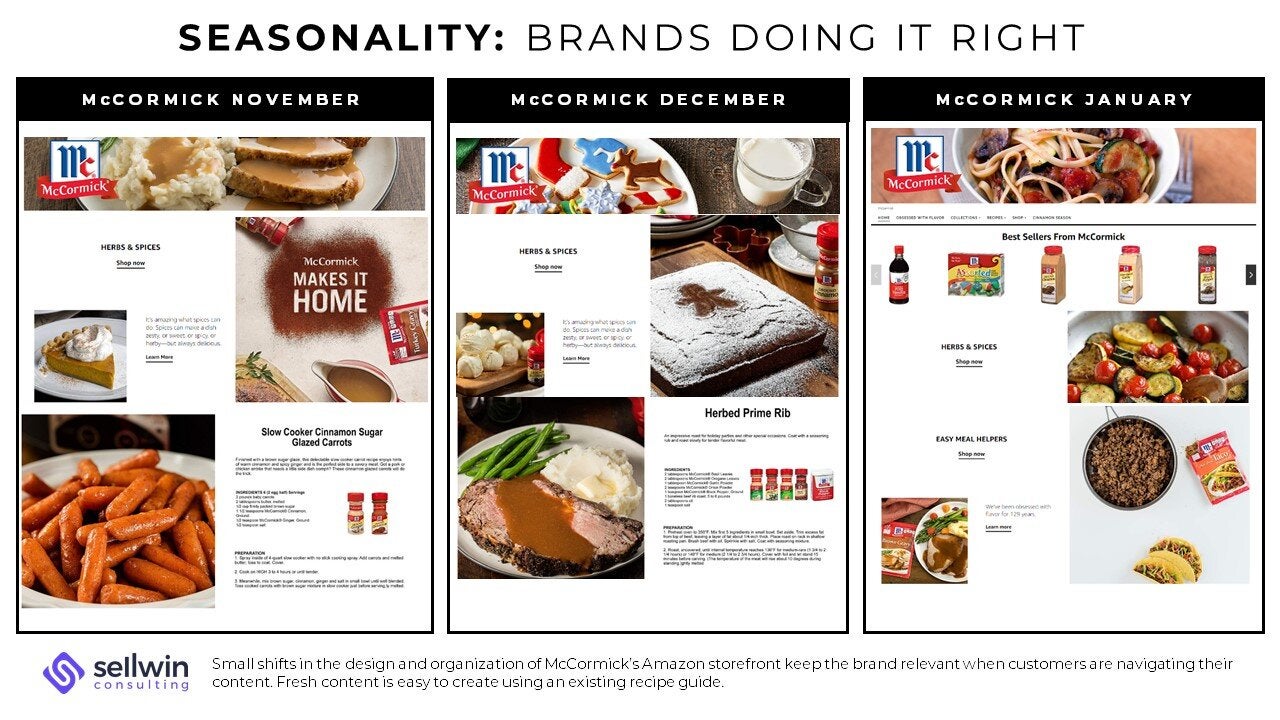
Brands Doing it Right: McCormick
McCormick is another brand who is successful in keeping up with seasonal content. Their Amazon brand store is robust, and minor tweaks to the overall store from Thanksgiving to Christmas and Chanukah had a major impression.
In these shots, you will see McCormick updated the header image to change the overall feel of their store and updated corresponding lifestyle images at the top of the homepage. Content focused on pumpkin pie during Thanksgiving was swapped out with truffles and a gingerbread man cake.
McCormick also has a recipes page which was refreshed so popular dishes for each holiday rose to the top. McCormick likely has a ton of recipes available from their catalog, so the changes in content would not require much extra work. These small shifts in the design and organization on their Amazon storefront keeps the brand relevant when customers are navigating their content.
In early January, McCormick transitioned back to a non-seasonal look and feel.
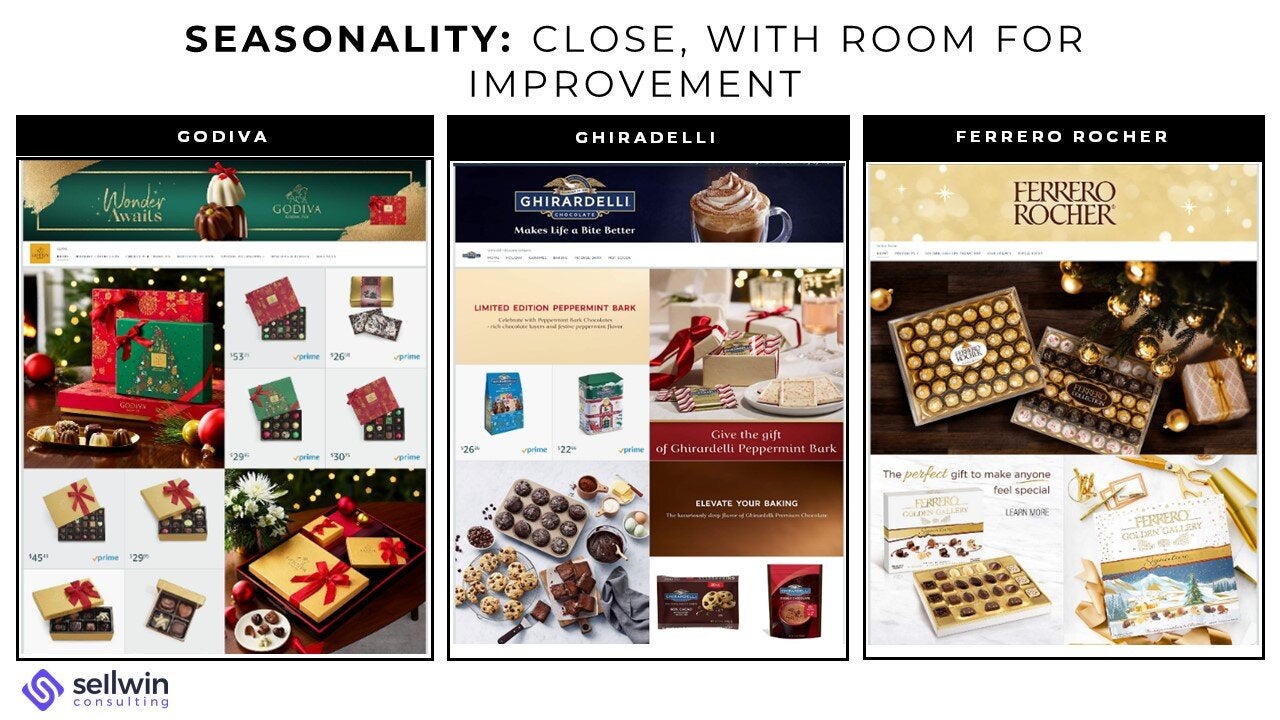
Needs Improvement: Godiva, Ghiradelli, and Ferrero Rocher
Like Hershey’s, Godiva, Ghiradelli, and Ferrero Rocher all updated their Amazon stores during the holiday season to feature holiday imagery and key products. However, they missed the mark on promptness, because their pages have not been yet updated for early January. Perhaps they are waiting to refresh with Valentine’s Day content that is not yet ready. We recommend always having an ‘interim’ non-seasonal store ready for the in-between season periods.
Additionally, a customer could expect discounts for holiday specific candy post the holiday season. This could be a good option for a brand in the weeks following holidays, to make slight adjustments to feature end of season sales. This is a common practice in brick & mortar stores, but these brands’ current online storefronts are not featuring sales for this candy in January, and customers may end up viewing Amazon as more ‘expensive’ than their local stores as a result.
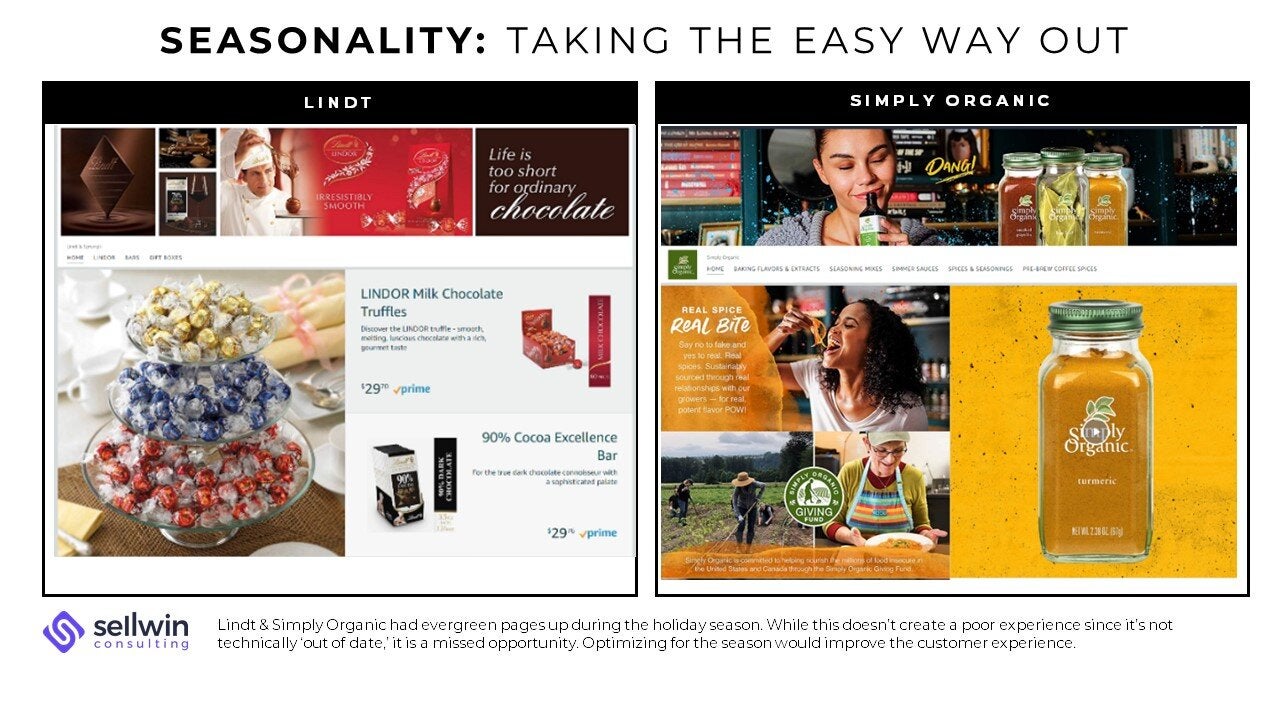
Needs Improvement: Lindt & Simply Organic
Lindt & Simply Organic had evergreen pages up during the holiday season. While this doesn’t create a poor experience since it’s not technically ‘out of date,’ it is a missed opportunity. Optimizing for the season would improve the customer experience.
For example, Lindt sells holiday-specific products like gingerbread, peppermint, and ‘snowman,’ but these products weren’t featured on the storefront at all. Customers would need to search for these products specifically to find them, and they would be unaware these were available when viewing on the store.
It’s unclear if Simply Organic’s page is evergreen or hasn’t been updated since the summer, which is not a good sign. While the bright colors and lifestyle images do pop, but they are not fitting for the winter season. Updating lifestyle images could be incredibly impactful to keep the page looking fresh. Slight tweaks to the product listing organization to focus on spices and seasonings most popular each season would also be more relevant for the customer.
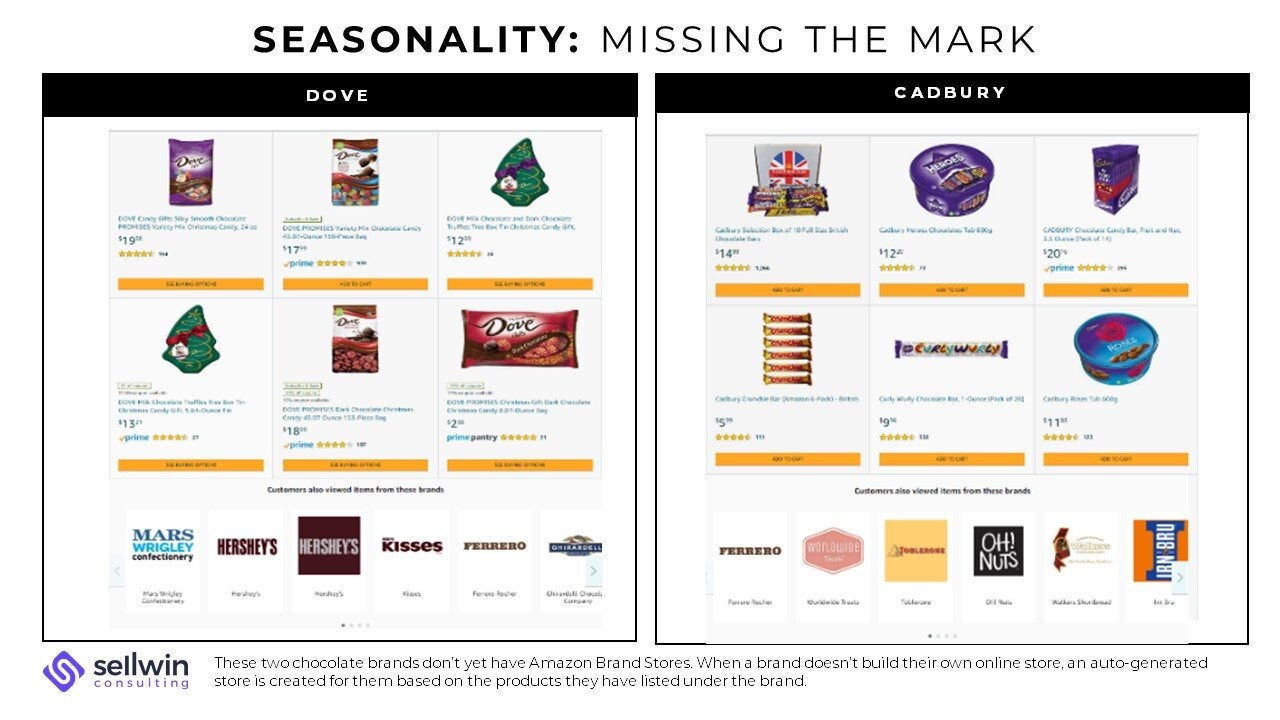
Missing the Mark: Dove & Cadbury
These two chocolate brands don’t yet have Amazon Brand Stores. When a brand doesn’t build their own online store, an auto-generated store is created for them based on the products they have listed under the brand. There are two major issues with this type of store: the products are not curated, and competitive brands are featured at the bottom of the page.
If those competitors have a well-designed store with a stronger experience for the customer, you may lose a sale. At the minimum, all brands should create an Amazon store in 2020 to defend their brand’s appearance and tone.
It’s important for brands to remember that even if they are not seeking to boost sales on E-Commerce, their online presence is still integral to the consumer journey. De-prioritizing their storefronts is no longer acceptable, and it’s more advantageous to create tailored content for each season than a robust amount of generic content that is out of date. Planning content calendars ahead and having an evergreen version available between seasons is highly recommended to keep your Amazon PDPs and stores fresh and informative for the consumer.
⭐ Update 1/14/2020 ⭐
A week after we published this post, Amazon rolled out a number of new Stores features. One of the additions is a scheduling feature that will make seasonal updates considerably easier. Here is how Amazon describes it (for the full list of updates, click here):
Stores Scheduling.To make it easier to manage your Store, you can now publish updates at scheduled dates and times, allowing you to plan ahead and align your Store's publishing schedule with new releases, seasonal changes, and brand updates. When you submit your updated Store for publishing, you can request a date and time at which the changes will be live to customers.
Pretty great news, right? This means you can implement all of the advice below -- like using varied content modules, repurposing seasonal content from other marketing efforts, and building an evergreen store page for the gaps between seasons -- then "set it and forget it," knowing that your new content will automatically update for the time and date that you choose.

